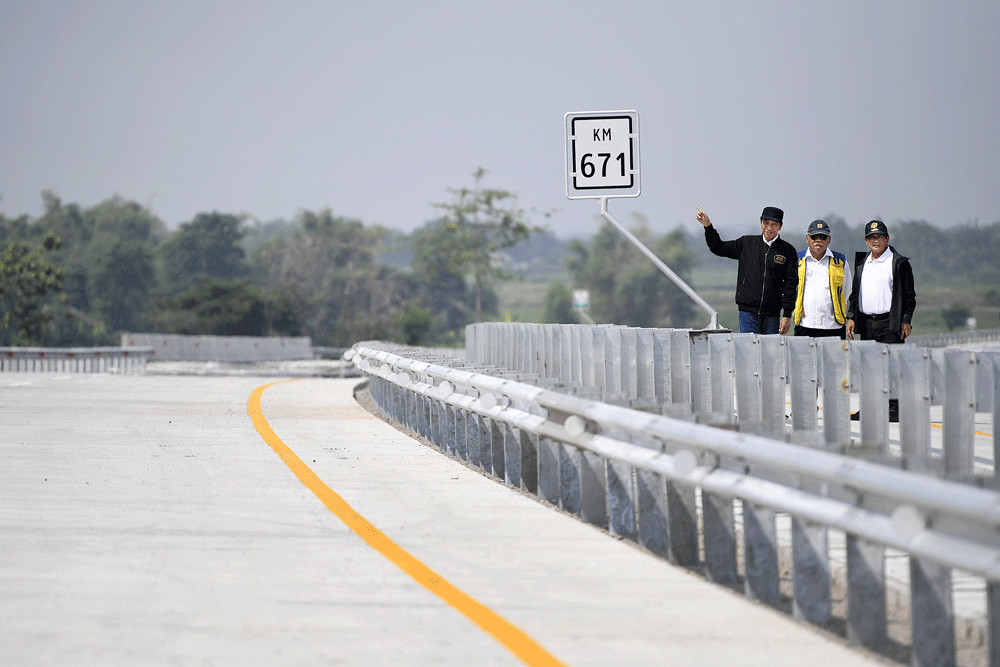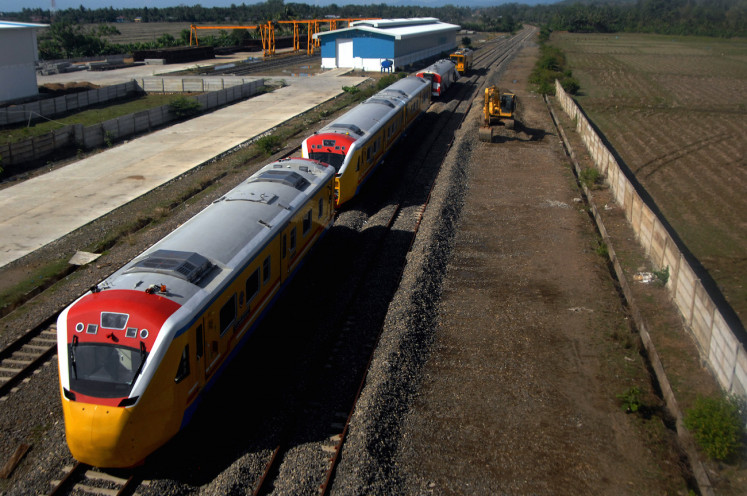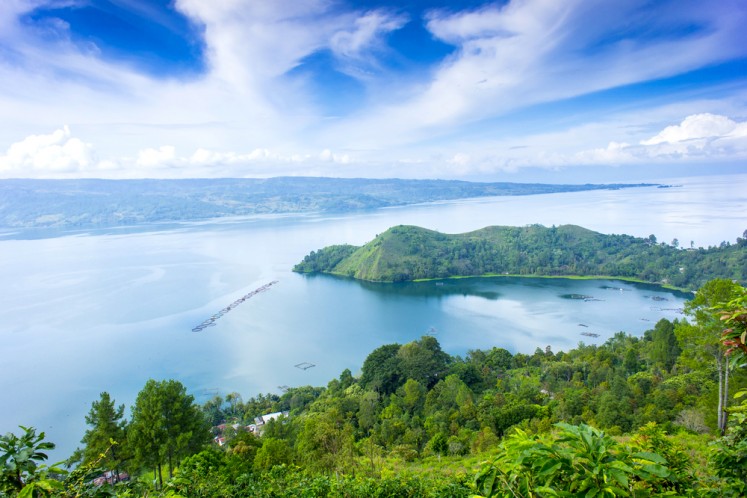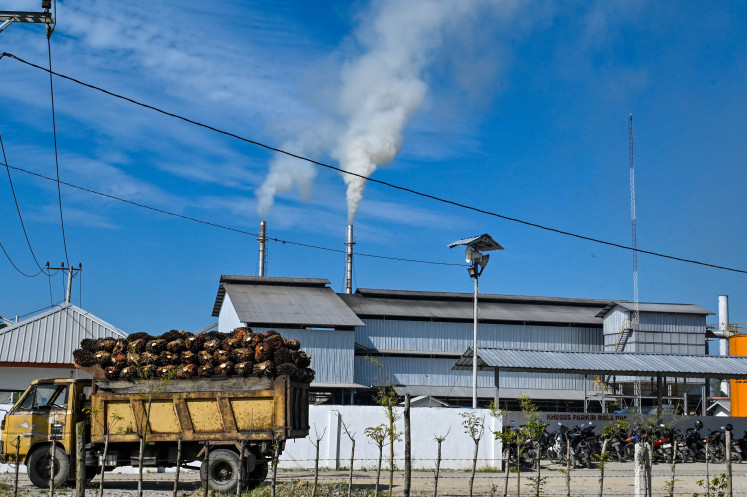Popular Reads
Top Results
Can't find what you're looking for?
View all search resultsPopular Reads
Top Results
Can't find what you're looking for?
View all search resultsNot all bad in 2018: Indonesian economic review
Natural and man-made disasters overshadowed growth in tourism and the transportation sector.
Change text size
Gift Premium Articles
to Anyone
 On the road again: President Joko “Jokowi” Widodo (left), accompanied by Public Works and Housing Minister Basuki Hadimuljono (center) and Cabinet Secretary Pramono Anung, inspects the newly completed Bandar Interchange in Jombang, East Java, on Thursday. Jokowi has inaugurated a total of seven sections of the trans-Java toll road, which stretches from Merak, Banten, to Surabaya, East Java. (Antara/Puspa Perwitasari )
On the road again: President Joko “Jokowi” Widodo (left), accompanied by Public Works and Housing Minister Basuki Hadimuljono (center) and Cabinet Secretary Pramono Anung, inspects the newly completed Bandar Interchange in Jombang, East Java, on Thursday. Jokowi has inaugurated a total of seven sections of the trans-Java toll road, which stretches from Merak, Banten, to Surabaya, East Java. (Antara/Puspa Perwitasari )
I
t has not been all doom and gloom in the economy this year. Some sectors reported positive growth, particularly in the administration’s infrastructure drive, tax revenue and the booming digital economy.
Natural and man-made disasters, however, overshadowed growth in tourism and the transportation sector.
The Jakarta Post looks at the ups and downs of 2018, and following is part two of the review, compiled by Marchio Irfan Gorbiano, Norman Harsono, Rachmadea Aisyah, Riska Rahman, Riza Roidila Mufti, Stefanno Reinard Sulaiman and Winny Tang.
Read also: Global trade war, upcoming elections weigh on the economy this year
Tax revenue
Despite the lower-than-expected realization as of November, the Finance Ministry’s Directorate General of Taxation maintains its optimism over this year’s target, thanks to better tax revenue growth.
Finance Ministry data show that as of November, tax revenue realization reached Rp 1.14 quadrillion, 16.77 percent more than last year and the highest growth recorded since 2012. (Antara Photo/Muhammad Adimaja)Although this year’s tax revenue so far has reached only 94.87 percent of the estimate in the 2018 state budget, or Rp 1.35 quadrillion (US$93.09 billion), Taxation Director General Robert Pakpahan said this year’s revenue would grow more than in previous years.
Finance Ministry data show that as of November, tax revenue realization reached Rp 1.14 quadrillion, 16.77 percent more than last year and the highest growth recorded since 2012.
Danny Darussalam Tax Center (DDTC) tax research partner Bawono Kristiaji said in a statement that this year’s tax revenue double-digit growth was all thanks to the recovering economic situation in some sectors, particularly mining, coupled with a softer approach toward taxpayers and ongoing tax reform efforts made without drastic regulatory changes.
Despite the high growth, the lower tax collection in November means another Rp 110 trillion needs to be collected in the last month of the year, which could be hard to achieve given the relaxations introduced recently by the government
Taxation Directorate General tax revenue and compliance director Yon Arsal said the government decided in June to decrease small and medium enterprises' income tax from 1 percent to 0.5 percent in order to boost their growth and help their cash flow.
Banks
Lenders recorded double-digit loan growth of 12.5 percent as of November, the same as the target set by the Financial Services Authority (OJK), although third-party funds grew only 7.19 percent year-on-year (yoy) in November, prompting concerns that banks’ liquidity could be negatively affected.
Major lenders such as private lender Bank Central Asia (BCA) and state-owned banks Bank Rakyat Indonesia (BRI), Bank Negara Indonesia (BNI), Bank Mandiri and Bank Tabungan Negara (BTN) all remain optimistic about booking double-digit credit growth by year-end.
In 2018, Indonesian banks faced the pressure of a gradual increase in Bank Indonesia's (BI) seven-day reverse repo rate. BI maintained its policy rate at 6 percent in December, despite the US Federal Reserve increasing its benchmark rate by 25 basis points to a range of 2.25 to 2.5 percent.
The increase in the BI rate prompted banks to raise their deposit rates. However, some banks have chosen to increase their lending rates slowly, considering clients' repayment capability. As a result of these conditions, banks’ net interest margins (NIMs) slumped as a result of the rising cost of funds.
With declining NIM, banks focused on jacking up their fee-based income by expanding their digital banking, as well as boosting efficiency, to ensure that they could record satisfactory revenue in 2018.
Infrastructure
Throughout 2018, the government finished several national strategic projects. As of November, 36 national strategic projects had been completed out of the total 223 listed, ranging from toll roads, airports and seaports to reservoirs.
As of October, the government had completed the development of 3,432 kilometers of national roads, 941 km of toll roads and bridges totaling 39.8 km in length.
The Public Works and Housing Ministry has also been is busy in post-disaster reconstruction efforts in West Nusa Tenggara and in Palu and Donggala in Central Sulawesi, with the construction of public facilities and temporary housing.
Earlier this month, President Jokowi inaugurated the trans-Java toll road, which connects the capital city of Jakarta to Surabaya, East Java, along a 741 km route.
Transportation
The year 2018 has been tough for the Transportation Ministry, with several transportation accidents, including bus, airplane and boat accidents, such as the Lake Toba passenger vessel tragedy and the Lion Air JT160 plane crash.
Escalating friction between ride-hailing companies that have been meeting demands by their drivers led to a new regulation on online transportation services, which Transportation Minister Budi Karya Sumadi said he had signed and was awaiting review by the Law and Human Rights Ministry.
In air transportation infrastructure development, the construction of airports, including Tjilik Riwut Airport in Central Kalimantan and New Yogyakarta International Airport, recorded physical development of 65.36 percent as of October.
In sea transportation, ongoing construction, such as that of Makassar New Port, Kuala Tanjung Port, Kijing Terminal Port and Bitung International Port, recorded physical development of 81.09 percent.
A train parks at a trans-Sulawesi railway project in Pekkae village in Barru regency, South Sulawesi, on Nov. 5. The railway will span 2,000 kilometers, connecting Makassar in South Sulawesi to Manado in North Sulawesi. (Antara/Abriawan Abhe)The government also recorded 64.65 percent development in several ongoing railway projects, including routes Makassar-Pare Pare in Sulawesi, Bandar Tinggi-Kuala Tanjung in Sumatra, Rantau Prapat-Duri-Pekanbaru also in Sumatra and the southern Java double-track railway projects.
Tourism
The government is likely to miss this year's target of attracting 17 million foreign tourists as only 13.24 million foreign arrivals were recorded as of October.
Tourism Minister Arief Yahya has predicted that the number of foreign arrivals might reach only 16.2 million by the end of the year. However, he was optimistic about reaching the target of 270 million domestic tourists this year.
A view of Lake Toba from the highland. (Shutterstock/-)Natural and man-made disasters have also slowed down tourism, especially since tragedy struck in some destinations dubbed the new Balis: Lake Toba, which saw a major boat accident, Mandalika in West Nusa Tenggara, which was rocked by earthquakes, and the latest, Tanjung Lesung in Banten, which was hit by a tsunami.
The surge in low-spending tourists, dubbed “zero dollar tourists”, who travel to popular destinations like Bali on cheap packages, has also had a negative impact on the government reaching its tourism revenue target.
Digital economy
It’s been a record year for Indonesia's digital economy as it grew to US$27 billion – the highest in Southeast Asia – from just $600 million three years ago, according to a Google report released last month.
The growth was spearheaded by the e-commerce sector, which accounted for 45 percent ($12.2 billion) of this year’s digital economy, indicating an ever-increasing shift toward online spending.
Similarly, British consultancy P-PRO says that Indonesia’s e-commerce market grew the most (78 percent) worldwide with a current value of $7.2 billion.
In line with the rise in online spending, a consortium of online retailers (such as Bukalapak, Lazada, JD.id and Shopee) secured a record high of Rp 6.8 trillion in transactions during the National Online Shopping Day (Harbolnas) festival earlier this month.
Trailing behind e-commerce, Indonesia’s three other largest digital economy sectors this year were online travel ($8.6 billion), ride-hailing ($3.7 billion) and online media ($2.7 billion).
This year also saw many large technology companies expand their services to become “super-platforms” such as Go-Jek, which has expanded into its 15th submarket this year with the launch of its coupon market Go-Deals.
The growth of e-commerce and super platforms, in turn, spurred the growth of the financial technology (Fintech) sector, particularly e-payment platforms such as OVO, which currently supports two Southeast Asian unicorns: Grab and Tokopedia.












